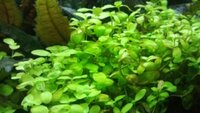AdrianT
Seedling
Anybody have experience treating a tank with purmycin? I've got an outbreak of cyanobacteria, presumably from low nitrate levels and potentially ammonia at some beginning stages from the Aquasoil. I hear it's 200mg for 10 gallons (45 litres). Is that correct? Thanks. I assume I've correctly identified the problem. This stuff comes off fairly easily in one's fingers, but grows back fast and is spreading. I see I have some hair/thread type algae growing too, and some green spots on the glass.
I'm told purmycin is going to kill the bacteria in my filter, another person says no. I have read about "blanketing" the tank to keep it dark for 4 days, not sure about that. And another suggestion is peroxide. Not to sure who to believe so I've come to this forum.
The tank is 260 display (1320mm long) with a 60 litre sump below. Was dry started using ADA Aquasoil for 3 weeks and been running 4 or 5 weeks now. CO2 is pressurised with a DIY inline reactor. Lights are 3 x 54 Watt T5's, (two 8800K Radiums, and one Grolux) and photoperiod is 8 hours. Using the EI technique, but been slack in the beginning and wanted things to settle a bit so hence my thought about low nitrates. Currently have about 20 shrimp, 6 galaxy rasboras and one small dwarf bristlenose pleco. I also have a Twinstar Nano running from the time it was filled. EDIT: I also have a wave maker running, so circulation is not a problem at all.
Pic of the algae:

Pic of the tank. Plant growth is about double since this photo was taken:

Thanks,
Adrian
I'm told purmycin is going to kill the bacteria in my filter, another person says no. I have read about "blanketing" the tank to keep it dark for 4 days, not sure about that. And another suggestion is peroxide. Not to sure who to believe so I've come to this forum.
The tank is 260 display (1320mm long) with a 60 litre sump below. Was dry started using ADA Aquasoil for 3 weeks and been running 4 or 5 weeks now. CO2 is pressurised with a DIY inline reactor. Lights are 3 x 54 Watt T5's, (two 8800K Radiums, and one Grolux) and photoperiod is 8 hours. Using the EI technique, but been slack in the beginning and wanted things to settle a bit so hence my thought about low nitrates. Currently have about 20 shrimp, 6 galaxy rasboras and one small dwarf bristlenose pleco. I also have a Twinstar Nano running from the time it was filled. EDIT: I also have a wave maker running, so circulation is not a problem at all.
Pic of the algae:
Pic of the tank. Plant growth is about double since this photo was taken:
Thanks,
Adrian



